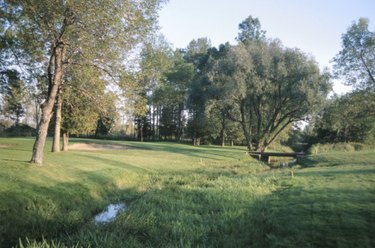
Ditches, or sloped trenches in your yard, along your driveway or in your fields, keep water away from low spots, roads and other important locations. Grass and weeds, which require mowing, often sprout in dry ditches. However, mowing a ditch can be difficult, inconvenient and even dangerous. Landscaping your ditches to avoid the need for mowing can produce a low-maintenance, attractive lawn and garden feature that still does its job.
Trees
Video of the Day
Once considered a poor choice for ditch planting, trees are now recommended for homeowners who wish to improve local water quality, save money and provide homes for wildlife. According to the Ohio Department of Natural Resources, leaving trees and other larger vegetation along at least once side of a ditch can reduce erosion and associated maintenance costs, as well as shade water for aquatic life and provide habitat for insects, rodents and other animals. Trees and shrubs may need occasional trimming, but reduce the need to mow.
Video of the Day
No-Mow Turf
Some ground covers and grasses never grow above a certain height. An occasional clipping and weeding is all they require. "Southern Living" magazine recommends mondo grass, an Asian grass also called monkey grass, for no-mow lawns and ditches. This plant gets only a few inches tall and produces white to purple flowers and blue fruits. This non-native can become invasive on some areas, though.
Other options include slow-growing fine fescue grasses, perennial peanut, violet and clover.
Wildflowers
Tall wildflowers make an attractive addition to a ditch, and require little to no mowing. Consider planting native wildflowers appropriate to your area, then simply allowing them to grow. Daylilies, black-eyed Susans, clover and wildflower mixes all work well.
Avoid Japanese honeysuckle and other fast-growing, vining non-native plants. They frequently escape their ditches, attacking nearby trees and establishing themselves elsewhere in the landscape.
Non-Plant Cover
Stones, gravel and other non-plant cover materials can significantly reduce the need to mow your ditches. A stone or gravel-filled ditch may also be called a French drain. Remove all plants, then fill the ditch with loose stones and gravel, rounding the top to prevent soil from accumulating on the drain. Occasional plants may grow between the rocks, but the drain will generally require little maintenance.
- Ohio Department of Natural Resources: Trees for Ditches
- "Southern Living"; Ditch the Mower: 8 Lawn-Free Landscaping Ideas; Rebecca Bull Read
- Wild Ones: So You Want a “No Mow” Lawn; Bill Sloey
- University of Florida: Guide to Using Rhizomal Perennial Peanut in the Urban Landscape; Robert E. Rouse, et. al; March 2010
- Purdue University: In the Grow Q & A; Bev Netzhammer; August 1996
- “River Cities' Reader”; Stop Mowing the Ditches; Rich Miller; Sept. 23, 2003
- Colorado State University: Soil Drainage; David Whiting, et. al; December 2009